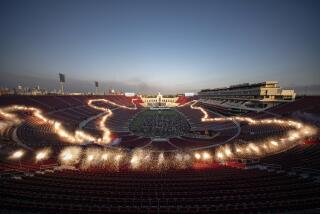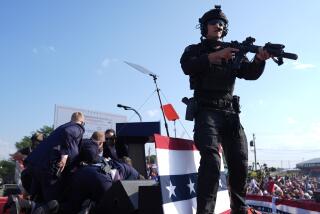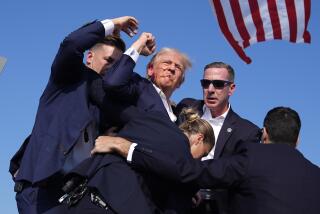At first, they thought it was fireworks — but it wasn’t. How a Las Vegas concert went from melody to mayhem

Allie Sibley speaks at a vigil about her experiences during the Las Vegas shooting.
Reporting from LAS VEGAS — Pop pop pop pop pop. As bullets rained onto the crowd gathered on the Strip for three days of country music, Travis Phippen’s training kicked in.
The off-duty emergency medical technician crawled from one victim to another, more than a dozen in all. They lay helpless and bleeding among the cowboy hats and plastic beer cups that concertgoers had dropped in panic when the shooting started.
Phippen plugged wounds with clothing. As he worked, a woman next to him was shot in the head.
He crawled to his next patient, a 240-pound man, and rolled him over.
It was his father.
The two men had traveled from Santa Clarita for the Route 91 Harvest Festival concert but were separated in the chaos. Now John Phippen, 56, was a casualty vying for Travis Phippen’s attention.
Phippen tried to plug the bullet hole in his father’s back with one of his fingers as he carried him to help. But it would not be enough.
A total of 59 people were killed and 527 injured when a gunman opened fire from a room in the Mandalay Bay hotel across the street.
It was the deadliest U.S. mass shooting in nearly a century, carried out, authorities said, by a reclusive real estate investor and gambler who’d hauled 23 weapons up to his 32nd-floor room and turned it into a hunting platform.
Police said Monday that a search of the home and computer of Stephen Paddock, 64, turned up nothing to explain why he had shot nearly 600 people assembled below on the concert grounds before killing himself as a police SWAT team burst through his hotel room door.
“It was an act of pure evil,” said President Trump, who will travel to Las Vegas on Wednesday. “Our unity cannot be shattered by evil, our bonds cannot be broken by violence.”
Authorities said 19 additional weapons were recovered from Paddock’s home in the town of Mesquite, Nev., 80 miles northeast of Las Vegas. Ammonium nitrate, which can be used to manufacture an explosive device, was found in his car, Clark County Sheriff Joe Lombardo said.
“Law enforcement were looking through his computer,” U.S. Rep. Ruben Kihuen (D-Nev.) said after being briefed by Nevada’s multi-agency anti-terrorism center. “They couldn’t find a motive.”
Those who had gathered for Sunday night’s festival described a night of laid-back music overcome by the crackle of gunshots so suddenly that at first no one knew what it was.
Country music star Jason Aldean was on his fourth or fifth song — “When She Says Baby,” a sugar-sweet love song — when the crowd heard the first pop.
Tom Cassidy, 60, of Calabasas saw somebody step on something, maybe a plastic bottle, and thought: Wow, that thing is loud. Others guessed it was fireworks, but there no fireworks were to be seen.
Then Cassidy saw a woman next to him. She had a hole in her face.
With a randomness that was heartbreaking, concertgoers learned the hard way that they were under attack.
Adrian Murfitt, 35, had put his arm around his friend from childhood, Brian MacKinnon, 33, for a photo. Both had come from Anchorage for the show. They heard the pops, and when Murfitt turned to look, a bullet hit his neck and knocked off MacKinnon’s hat. Murfitt died in his friend’s arms.
The shooting seemed to last about 10 minutes, much of it rapid-fire, suggesting the gunman had a fully automatic rifle. Aldean and his band ran offstage, and the crowd panicked.
Karlie Cruz, 21, called her mom and left a voicemail: “There’s an active shooter. I’m OK — for now. I love you.” But she still had to escape.
Suddenly, a concert space that had been designed for openness, to accommodate as many people as possible, but also fenced in to provide security, was now a free-fire zone with precious little cover and little chance of escape.
Dozens of people cowered under bleachers. Some, stunned, sat frozen in their seats as others tried to pull them down.
Desera Prosser, 37, and James Glass, 36, had come to Las Vegas to get away from their home in Naples, Fla., damaged in Hurricane Irma. Like many others, they became separated in the chaos and the crush of people.
Glass hid behind a beer cart. He felt a bullet whiz by. He looked up and saw a hole in the beer cart. He ran.
Prosser took cover beneath a food vending truck. After she decided to run, a woman a few feet in front of her was shot in the back. Prosser kept running.
Some helped others hop over the fences to escape. “There was a 3- or 4-foot gap in the fence, and everyone was trying to squeeze through it,” said Brian Claypool, a Los Angeles attorney.
Some injured survivors were carried away in wheelbarrows. Streets were littered with abandoned heels, skirts and shirts torn off in the chaos.
Once out, some crammed into strangers’ cars to escape. Many flooded into nearby hotels. They hid in strangers’ hotel rooms and in restaurant freezers.
Loved ones received desperate phone calls. Mavis Barnette was almost asleep when she received a phone call about 11:30 p.m. from her daughter’s friend. Her daughter had been shot in the chest.
“What are you talking about?” Barnette said. “Where? When? What?”
Her daughter, Carrie Barnette, 34, died before reaching a hospital.
Police started to flood the area, and some officers loaded multiple victims into the backs of their squad cars to take them to hospitals. “We’re going to have a lot of people self-transporting in pickup trucks,” one officer radioed.
The nearby cluster of hotel towers created an echo that made it seem as though the barrage was coming from everywhere. Many thought the gunman was on foot, inside the concert space and getting closer.
In the confusion, police confronted passersby at gunpoint outside the nearby T-Mobile Arena, forcing them to lie facedown on the sidewalk.
As off-duty Los Angeles Police Department officer Joel Twycross ran out of the concert venue — a gun-free zone — he saw people pointing toward the glimmering Mandalay Bay hotel.
Muzzle flashes illuminated one of the windows.
Police and SWAT teams streamed into the building.
Police said they coordinated with hotel security to narrow down what floor the gunman was on.
When a security guard approached Paddock’s room, the gunman fired through the door and struck him in the leg, police said.
A “strike team” of police assembled to breach the door.
“We need to pop this and see if we’ve got any kind of response from this guy,” one officer whispered into his radio from near Paddock’s room, trying to keep his voice down, as he and other officers prepared an explosive charge for the door.
“All units move back, all units move back,” a dispatcher said.
“Breach, breach, breach!” one of the officers said, a transmission that was followed by the sound of an explosion.
But Paddock had killed himself, leaving behind no manifesto explaining what he’d done, officials said later. “We have one suspect down inside the room,” one official radioed.
But the night had only just begun.
A University Medical Center nurse called clinical supervisor Toni Mullan and gave her a blunt instruction: “Mass casualty incident. We need you in.”
“I hung up,” Mullan said. “I didn’t even ask questions.”
The wounded poured in on trucks, in taxis, in police cars, in ambulances, some even driving themselves — 104 victims at that facility alone, the area’s only Level 1 trauma center. Staff started doing triage in the parking lot; blood was splattered across the entrance.
Along with the crush of wounded, though, came an invasion of support: hospital staff who showed up unasked, medical professionals and nurses visiting from out of town showing up and offering to help.
Dr. Jay Coates, a trauma and critical care surgeon at the center, arrived at 11 p.m. and began doing surgeries nonstop for the next six hours.
“I had no idea who I was operating on,” Coates said. “The were coming in so fast, we were taking care of bodies.”
The victims didn’t have the relatively contained trauma of wounds from handguns, but complex wounds from high-velocity rifle rounds, which often fragment when they hit their victims.
“You had people with lung contusions, liver and spleen contusions, broken bones,” Coates said. “It was like a war zone.”
John Phippen hadn’t made it — despite the efforts of his son, who’d struggled to haul his father to safety in time to stop the bleeding. As it turned out, Travis Phippen had been shot too, in the right arm, but hadn’t noticed in the rush to save his father.
“He was my best friend,” Phippen said Monday. “He never did anything wrong to anybody. He was always kind and gentle. He was the biggest teddy bear I knew.”
Feeling helpless and wanting to do what he could to help, Rep. Kihuen showed up at the Sunrise Hospital & Medical Center at 3 a.m.
“Every single bed was occupied. Every room was occupied in the emergency room area. Every single hallway had patients on beds because they didn’t have enough space in the rooms,” said Kihuen, who still sounded shaken 12 hours later. “People were turning purple.”
At about 4:20 a.m., Mason Van Houweling, chief executive of University Medical Center, stood with the police officers outside his building and praised the “miraculous” work of his staff.
But then his eyes grew cloudy. “It’s like a bad dream,” he said.
An ambulance soon pulled up with a man on a stretcher. He was conscious and shirtless, with a large wrap around his abdomen.
As the sun rose, hundreds of volunteers in the city lined up to give much-needed blood donations for the victims in the local hospitals. Bodies still lay on the ground as police began the massive task of documenting evidence and identifying the dead.
Those who’d been at the concert the night before were easy to spot as they lingered, still wearing their cowboy hats. This was a city used to late nights that stretch into the early morning — but not like this. Not like this.
“We just wanted to come and have a great weekend,” said Robynn Hernandez, 47, of Santa Clarita, who was still wearing her cowboy boots and purple concert wristband.
“And we did,” Hernandez said, her voice shaken. “Up until then.”
Potts and Mather reported from Las Vegas. Poston and Pearce reported from Los Angeles. Staff writers Matt Hamilton contributed reporting from Las Vegas, and Laura J. Nelson, Melissa Etehad, Sonali Kohli, Richard Winton, Benjamin Oreskes and Makeda Easter contributed reporting from Los Angeles.
Matt Pearce is a national reporter for The Times. Follow him on Twitter at @mattdpearce.
ALSO
When the shooting stopped, 59 distant lives ended together
From the 32nd floor, gunman caused mass carnage despite security measures
The mystery of Stephen Paddock — gambler, real estate investor, mass killer
More to Read
Sign up for Essential California
The most important California stories and recommendations in your inbox every morning.
You may occasionally receive promotional content from the Los Angeles Times.














